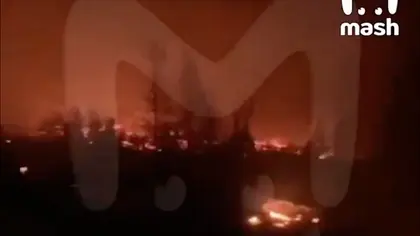The Security Service of Ukraine (SBU) has blown up a second train in two days on the Baikal-Amur railway line deep inside Russia, sources have told Kyiv Post.
A source in Ukraine’s military leadership said it was a carefully planned operation that took advantage of the chaos caused by a strike a day previously in the Severomuysky Tunnel.
JOIN US ON TELEGRAM
Follow our coverage of the war on the @Kyivpost_official.
“The Russians were twice trapped by the SBU — another fuel train exploded on the Baikal-Amur railway line,” the source said.
In order to circumvent the damage caused by the first attack, Russian trains began using another route that passes through the "Chortov Most" ("Devil's Bridge"), a semicircular viaduct on the Northern Bypass of the Baikal-Amur line.
“This is precisely what the SBU was counting on: when the train was passing over this 35-meter high bridge, the explosive devices embedded in it went off,” the source said.
In a previous comment to Kyiv Post, the source said the railway line was being used to transport military supplies.
Russian social media confirmed that another train was blown up overnight. Four fuel tankers from the train were destroyed, and two more were damaged by fire.
According to preliminary reports, fuel spilled over an area of 150 square meters.
"Russian special services should get used to the fact that our people are everywhere, even in distant Buryatia," the source added.
Kyiv Post contacted the SBU directly to confirm or deny this information but did not receive a response.

Man Pleads Guilty in UK Over Russia-Backed Arson Attack
Previously on Thursday, sources told Kyiv Post that the SBU had detonated a freight train in a tunnel on the crucial rail link.
The operation, conducted overnight, targeted the Severomuysky Tunnel on the Baikal Amur Mainline, situated deep inside Russia, north of Mongolia.
A source in Ukraine’s military leadership revealed to Kyiv Post that four explosions were directed at the train as it traversed the tunnel.
They added: "Currently, the Russians use this route, including for military supplies. After the explosion, it was paralyzed."
In a separate development, Moscow said on Friday it had arrested a dual Russian-Italian national for carrying out sabotage attacks on military installations and a train line under the orders of Ukrainian military intelligence.
Moscow has opened dozens of cases into alleged sabotage at key infrastructure and production facilities, as well as attacks on military recruitment centres since its military intervention in Ukraine began, AFP reports.
The FSB security services said in a statement the suspect – a native of the Ryazan region south of the capital – had derailed a freight train using an explosive device last month.
The improvised explosive derailed 19 train carriages in early November in the Ryazan region, the FSB said.
The individual, born in 1988, "placed homemade explosive devices on the railway line," it said, adding that the suspect was also responsible for an earlier attack on an airfield in the same region.
It claimed the man had "confessed to having been recruited by the Ukrainian military intelligence service" in February.
The attacks this week are just the latest in a string of successes for the SBU on Russian and Russian-occupied territories since the start of the full-scale invasion.
In a documentary titled “Special Operations for Victory,” broadcast Nov. 24 on Ukrainian TV channel 1+1, the head of the SBU and other military officers released details of two attacks on the Kerch Bridge, two of the most significant to date.
So far, Ukraine has conducted two successful strikes on the Kerch Bridge that serves as a logistic lifeline between occupied Crimea and Russia’s mainland.
The first attack took place on Oct. 8, 2022, a day after Russian President Vladimir Putin’s 70th birthday, which set the bridge on fire.
While most information for the attacks was gathered through open-source channels, a video posted by a woman on a yacht proved to be essential in determining the integral structure of the arch supporting the bridge, according to a counterintelligence officer operating under the callsign “Racoon.”
Read the full report here.
You can also highlight the text and press Ctrl + Enter






